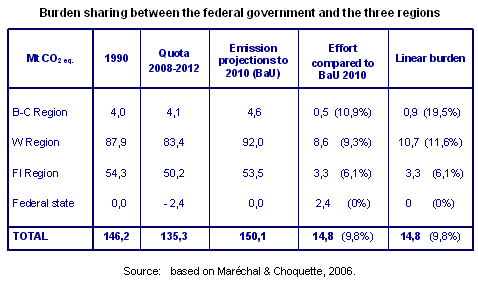(back to the Documentation)
The Belgian climate policy mechanisms
Six major policy mechanisms have been implemented in Belgium in order to complete the Belgian climate policy :
- the Coordination law on sustainable development ;
- the Cooperation agreement for the climate ;
- the National climate plan 2002-2012 ;
- the Internal burden sharing arrangement ;
- the National allocation plans ;
- and the Complementary cooperation agreements.
1. Coordination law on sustainable development
On 5 May 1997, a coordination law on the federal policy for sustainable development was adopted.
In this framework, the second federal plan for sustainable development 2004-2008 was decided on 24 September 2004. This plan is not legally-binding and covers six themes, one being related to the mitigation of the climate change and the promotion of the use of renewable energies. Progress in the implementation of the mentioned measures is reported in an annual report and a new plan has to be adopted each four years.
2. Cooperation agreement for the climate
A cooperation agreement between the federal government and the three regions was signed on 14 November 2002 to elaborate, implement and follow up this plan and to draw up mandatory reports for the UNFCCC, the Kyoto Protocol and decision n°280/2004/CE related to the control mechanism of GHG emissions.
The National Climate Commission (NCC) was set up, to act as the executive body of the cooperation agreement (see also Belgian climate policy for more detail on the NCC).
3. National Climate Plan 2002-2012
The national climate plan is considered as the second climate policy pillar of Belgium. It is in fact an annex to the cooperation agreement for the climate. (1)
This plan aiming at allowing Belgium to fulfil its commitments within the UNFCCC and the Kyoto Protocol was adopted by the Interdepartmental Conference for the Environment (see also Belgian climate policy for more detail on the ICE) on 6 March 2002.
It describes for each public authority level and each sector the different policy measures already implemented / to be implemented / designed or studied. It is a real synthesis document concerning how the Belgian policy will tackle climate change.
4. Internal burden sharing arrangement
Within the framework of the cooperation agreement and under the auspice of the National Climate Convention (see also Belgian climate policy for more detail on the NCC), the federal government and the three regions signed an internal burden sharing arrangement on 8 March 2004 to determine the contribution of each level of power in the fulfilment of the national Kyoto target (see Table hereafter), in accordance with the climate policy competence sharing (see also Belgian climate policy for more detail on the competence sharing).
This agreement, based on a not legally binding compromise solution, was essential for the Belgian climate policy to work on an effective way. In the Kyoto context, such an arrangement is an exception.(2)

|
The former 1990 reference was set at 138,7 Mt CO2-eq. but after some adaptations in the emission calculations, the final result has been fixed at 146,2 Mt CO2-eq. (second column of the table here above) which means that the Kyoto target for Belgium in 2012 is set at 135,3 Mt CO2-eq..
Each of the three regions has its own target to reach in 2012 (third column of the table here above): the Brussels-Capital region was authorised to increase its emissions by 2,5%, while the Walloon and Flemish regions have to reduce their emissions respectively by 5,1% and 7,5% and the federal state will introduce complementary measures (on aspects handled at the federal level) to cut down Belgian emissions with another 2,4 Mt CO2-eq.. In addition, the federal state will implement different measures to reduce GHG emissions from road transport, electricity production, citizens' energy consumption, etc. aiming at cutting the national emissions with 4,8 additional Mt CO2-eq., which will mitigate the real efforts (fifth column of the table here above) to be made by the regions to reach their respective target compared to their respective emission forecast (BaU scenario) in 2010 (fourth column of the table here above).
5. National Allocation Plans
Compared to the Kyoto Protocol, the EU Emission Trading Scheme adopted in 2003 (3) only covers specific sectors and big installations. The National Allocation Plan gathers the emission levels authorized by the state for each of its installations concerned by the EU-ETS. Seeing that there is no emission ceiling on the EU-ETS, member states decide by their own the burden sharing between the EU-ETS installations and non EU-ETS sectors and installations, inside the Kyoto national "envelope". This means that the allocation process differs in all EU member states and that competing companies could be treated differently according to which country their installations belong to.
In Belgium, the three regions and the federal state have their own allocation plan to be compiled in the National Allocation Plan. The first Belgian NAP has been accepted by the European Commission on the 20th of October 2004 after several modifications.
For the second allocation period, the European Commission has approved the Belgian proposal on the 16th of January 2007.
6. Complementary cooperation agreements
- In September 2005, the National Climate Commission and public authorities signed a cooperation agreement concerning the organisation and administrative management of the National Register (4). A royal order related to the management of this national register has been adopted on 14 October 2005. (5)
- A second cooperation agreement was adopted in 2006 for the implementation of Kyoto Protocol flexible mechanisms.
